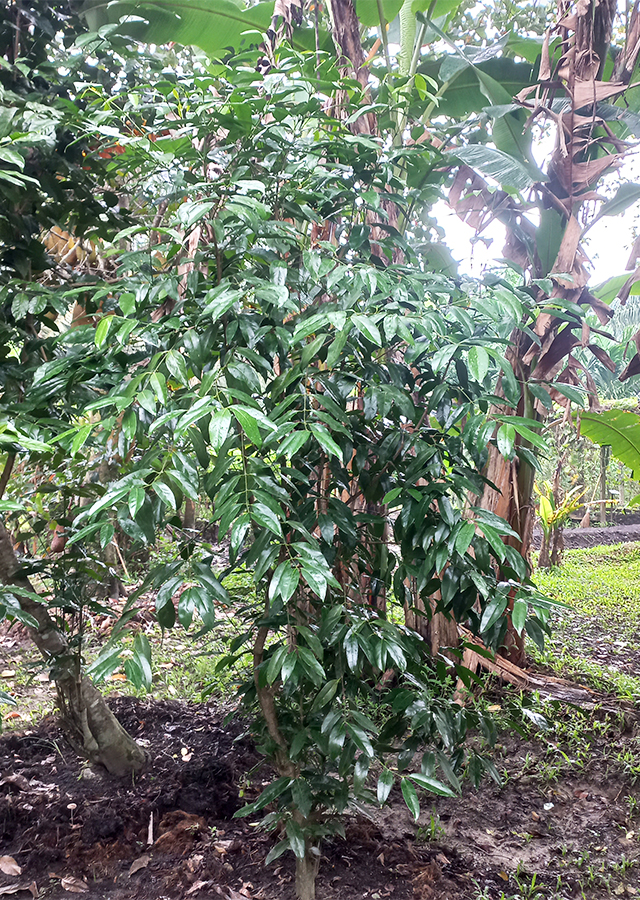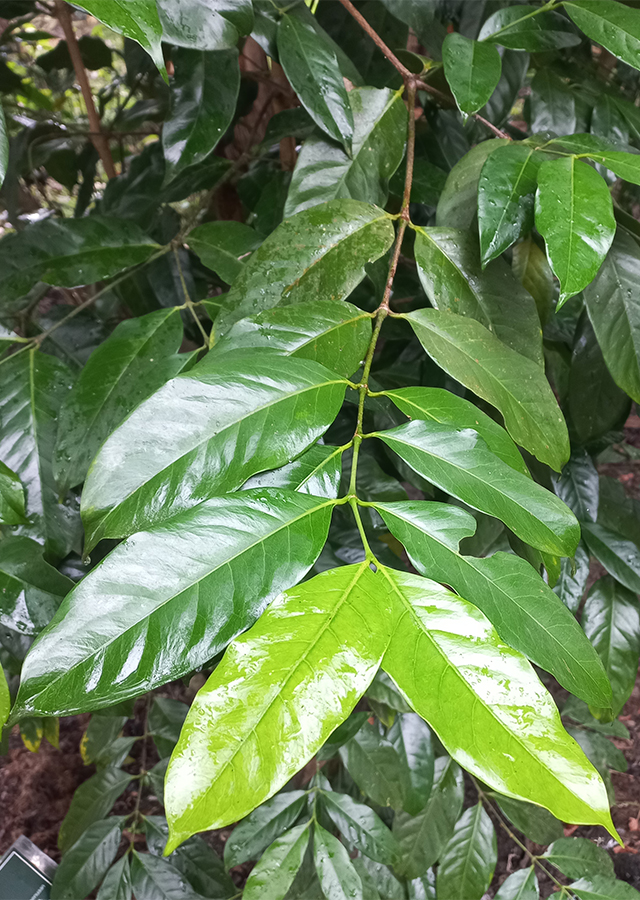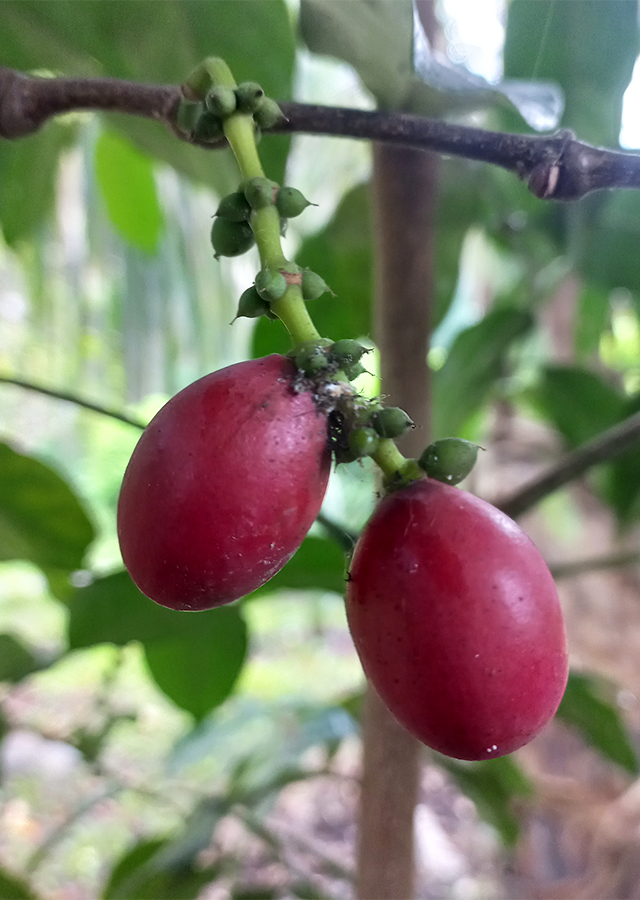Melinjo
Gnetum gnemon L.
Gnetaceae
Location in our garden
Hardwood



Synonym
Gnetum domesticum Reinw. ex E.A.Duchesne
Habitus
Trees. An evergreen, dioecious slender perennial tree that grows 5-10 m tall
Part Used
Leaves
Fruit
Roots
Sap
Growing Requirements
Full Sunshine
Need Shade
Drought Resistant
Habitat
Forest
Coastal
Roadside
Terrestrial
Overview
Gnetum gnemon is native of the place from North-East India to Fiji which is used in several traditional medicines to cure various diseases. It is widely planted as a home garden tree or for field boarders, agroforestry and soil improvement purposes in many places of South-East Asia. In Indonesia and Malaysia, Melinjo has been consumed as safety foodstuff for centuries. The young leaves, inflorescneces and tender tips are edible and used as a vegetable in Assam, mostly by Karbi tribe. The weed is used for making boxes, toolhandles, as well as soft timber. The bark fibres are processed into rope making, fishing net and high grade paper products. This species is rich in nutritional composition such as fiber, protein, carbohydrates, minerals and vitamins.
Vernacular Names
Gnetum a feuilles comestibles (French), Guan zhuang mai ma teng (Chinese), Melinjau (Malaysia), Peesae (Thai), Gam cay (Vietnamese). Voë khlaèt (Cambodian).
Agroecology
Melinjo grows at the hillsides in primary and secondary forests of the tropical rainforest climate with bimodal or uniform rainfall patterns. It does not tolerate salt spray and can’t grow in the coastal areas, at elevations up to 1,200 m. Prefers fullsun and moderate water.
Morphology
- Stem - well branched and possessed cylindrical bole and diameter up to 40 cm.
- Leaves - petiolate, ovate-oblong or elliptic, 10 to 20 cm long and 4 to 7 cm broad, reticulately veined, glabrous and shiny, dark green, apex acute to sub acuminate, margins entire, base acute and phylotaxy opposite; young leaves are reddish purple.
- Flower - inflorescences are borne on young shoots and older branches. Possessed aggregated cone or strobili at terminal stem axis in female plants and terminal 3-5 cm long axis of staminate strobili in male plants, only a few ovules in a spike develop into seeds.
- Fruit - nutlike, ellipsoid, 1-3.5 cm long, shortly apiculate, almost velvety, yellow turning red to purple when ripe.
- Seeds - 1 per fruit, large and horny, sessile, 1-3 cm long, ellipsoid in variety brunonianum and globose in variety griffithii. In mature seeds the middle envelope is stony and the outer most is fleshy. Seed coat is thin and brittle, and separates readily from the seed.
Cultivation
- Generative propagation is by seed.
- Vegetative propagation is by air layering, cutting, and grafting.
Chemical Constituents
Saponins, alkaloids, tannins, phenols, flavonoids, amino acids, and stilbenoids (trans-resveratrol, gnetin C, gnetin L, gnemonoside A, gnemonoside C, and gnemonoside D).
Traditional Medicinal Uses
- It has been used in folk medicines for the treatments of arthritis, bronchitis, asthma, diabetes and cardiovascular diseases.
- Roots used as antidote for poison and as medicine for malaria.
- In Malaysia, ripe fruits eaten for stomach cleansing and to prevent constipation.
- Studies have suggest antitumor, tyrosinase inhibitory, antioxidant, antiplasmodial, hypouricemic, hypolipidemic, angiotensin enzyme inhibitory, immunomodulatory, anti-aging, antidiabetic, analgesic properties.
Part Used
Reference Sources
- Bharali, Pankaj, et al. (2018). EVALUATION OF ANTIOXIDANT AND PROXIMATE COMPOSITIONS OF THE LEAF EXTRACT OF GNETUM GNEMON L. INTERNATIONAL RESEARCH JOURNAL OF PHARMACY, 9(10). DOI: 10.7897/2230-8407.0910234.
- Barua C. C., Haloi P, Barua I. C. (2015). Gnetum gnemon Linn. : A Comprehensive Review on its Biological Pharmacological and Pharmacognostical Potentials. International Journal of Pharmacognosy and Phytochemical Research, 7(3); 531-539.
- Kew Royal Botanic Gardens. (No date). Plants of the World Online: Gnetum gnemon L. https://powo.science.kew.org/taxon/urn:lsid:ipni.org:names:383520-1. 06-01-2023.
- National Park of Singapore. (2022). Flora Fauna Web: Gnetum gnemon L. https://www.nparks.gov.sg/florafaunaweb/flora/2/9/2942. 06-01-2023.
- Stuartxchange. (2022). Philippine Medicinal Plants: Bago. http://www.stuartxchange.org/Bago. 06-01-2023.
- Verheij, E.W.M., and Sukendar. (2016). Gnetum gnemon (PROSEA). https://uses.plantnet-project.org/en/Gnetum_gnemon_(PROSEA). 06-01-2023.


